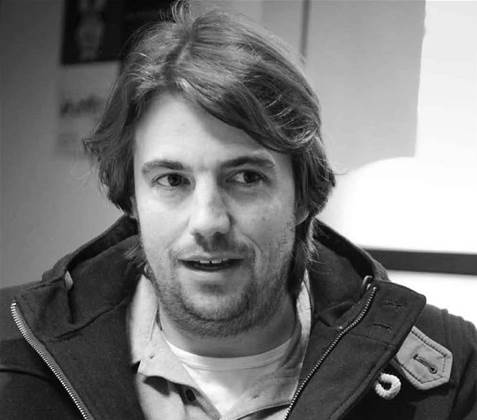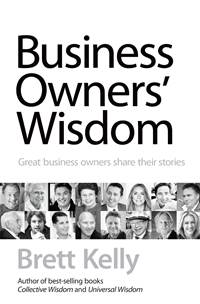Atlassian CEO and co-founder Mike Cannon-Brookes met his business partner, Scott Farquhar, while students at the University of New South Wales.

Today the company has offices in Sydney, San Francisco, Amsterdam and Tokyo, employs over five hundred people, has over 25,000 customers and achieved revenues of $59 million in 2011. Mike Cannon-Brookes and Scott Farquhar were ranked No.1 in the 2012 BRW Young Rich list, with a shared fortune of $480 million.
Cannon-Brookes spoke to author Brett Kelly as part of the latter's new book, 'Business Owners' Wisdom', an extract of which is below:

BK: Will the business go public at some point?
MC-B: That’s a potential outcome for us, sure, in the future.
BK: Is it a goal?
MC-B: I don’t know if it’s a goal. I think if it’s the thing that makes the most sense for the business at the time, then we will do that. I mean, we’re of the size now that it’s a possibility. It’s not a question of, ‘We need to be this much bigger to make that happen.’ It’s a question of when the business is ready for it. There are a lot of good things that come with going public. It’s playing in the big league.
It means you have to be excellent in everything you do. If you appreciate the capitalist process, the fact that there are so many rules and regulations on public companies is a good thing because it means that they have to be very well administered businesses, right? So the shareholders don’t get screwed. At the same time, some of those rules and regulations obviously inhibit some of the growth possibilities of those businesses. So it’s about the right timing – when it makes sense for the business. Sure, it’s a possibility.
BK: A lot of young people who are interested in building technology companies would say, ‘I know that you did a private equity raising, but how have you funded the business over the last ten years?’
MC-B: We’re very unusual. We always say, don’t copy us as a model. Well, copy us if you can, but don’t use it as a case study on how every business should run. We were bootstrapped for eight years – we didn’t raise any money for the first eight years. We were profitable, growing very, very fast and heavily invested the profits of the business back in growth every year. So there were eight years with no fund raising, then we raised $60 million from a tier one US venture capital investor, Accel Partners.
BK: How much of the company did they buy at that price?
MC-B: A pretty small piece.
BK: Was that public?
MC-B: No. It’s like a very small piece of the business.
BK: Now, when you say you were bootstrapping it, does that mean you were on a subsistence-type wage? What sort of money were you guys pulling out just to live on?
MC-B: That’s the old chestnut. Profitable from day one clearly means on day two you weren’t paying yourself anything. We didn’t pay ourselves for probably six or nine months, as in zero salary. Then, from nine months to about two years, we paid ourselves very, very little, a couple of hundred dollars a week sort of thing. After that we paid ourselves a pretty modest salary for a very long period of time.
BK: What was it?
MC-B: Around forty, fifty grand, something like that. It’s an interesting thing, right, because at some point, you can pay yourself more. I mean, we were being paid a modest salary for a far longer period than was necessary for the business.
BK: You get into the habit.
MC-B: Well, you get into the habit and your financial outcome is more dependent on the growth of the business than the salary that you’re pulling out. So, if you don’t necessarily need it, then why not? You think, ‘Well, if I put it in the bank, that’s not going to help me. I’d rather invest it in the business.’ So we took that long view for a long period of time. The only thing that changed it was our CFO complaining that everything should be commercially accurate, market rates etc.
It was a CFO-driven change and even now, our CFO is still arguing that it’s not at market rates.
BK: When the private equity guys came in, was it a long process? A difficult process? What was it that you thought that you had to have prepared most in order to make that as successful as it was?
MC-B: Good question. A few things. We spent a lot of time with the private equity guys before that. So, for the first three years of the business, no-one cared. Then, from about year four to about year eight, there was a five-year period where we didn’t want to raise any capital. We didn’t need to at that point. We probably weren’t growing so why would we bother? But the smart thing we did was we were very honest with them. We’d always say, ‘Hey, we’re not going to raise any capital, so there’s really no point meeting.’ And they’d always say, ‘Ah, but we’d love to catch up anyway, just to have a coffee.’ So we tried to always schedule lunches or breakfast so it didn’t take any time out of my day.
Then we created a spreadsheet that our PA maintained of all the firms we’d met with, basically if we liked them or not on a personal level. Then, around 2010, we were about eight years into the business and we were really thinking, ‘What do we want to do here? Do we want to sell the business? Do we want to recommit for another eight years?’ Both of us got married around that time so we took a little time off. I had a three-month break. We both went travelling with our wives and just reconsidered life a little bit. We decided that we had a lot more to achieve in the business. We wanted to recommit and therefore looked at the next eight-year goal, going public and a whole bunch of other things. We thought we probably needed a partner to help us do that. There were a lot of big challenges to get over. Also, there’s a thing in software that a hundred million is the ceiling that a lot of businesses struggle to break. They come out with a good product, a good service and can kind of scope it at twenty million, thirty million, forty million, so to fifty and a hundred million it starts to flatten out. They go like twenty, forty, sixty, eighty, eighty, eighty, eighty, and then there’s a big problem. We wanted to hit through the hundred and keep going. That was a big thing for us.
So, we looked around and we brought on these guys. When we ran the process, it was very simple. Again, we employed our game theory hats, talked to five firms, told them we were only talking to five firms, told them we were going to pick one, shared exactly the same information with all of them, controlled the process, told them exactly when we were going to be in the States, what pitches we were willing to do, gave them a bunch of time that they’re free to do whatever they wanted, a couple of hours. Anyone that asked a question, we shared the answer so there was totally equal information.
We were very clear on what we wanted. We said we wanted a partner. We said how much of the business we wanted to sell. We said that it was clear that we were going to be in control. At the time, we controlled 100 percent of the business between the two of us. So, you’re buying a very small piece. You either like what we’ve done, understand the fact that we’re in control and want to ride with us as a partner or not. So, we were very clear on what we wanted in the timing and how clean we wanted to be. Some of them turned up. We gave them all one shot. It was a one-bid process. We didn’t want to run a whole process. We told them there were five criteria that we would rank all the bids on in terms of how much we liked the firm, how much they had helped us out or we felt they could help us out all the way through valuation and obviously the financial metrics.
BK: So what were those five things? How much you liked them? How much you felt they could help you?
MC-B: Personal connection was a big one for us so we tried to meet as many people from the firm. We looked at it as a hiring decision. We were hiring a partner. Were they going to help us out for five years or were they going to help us out for six months, that sort of thing. We got references from all the firms on entrepreneurs they had worked with, were currently working with and had worked with in the past, even the people who had left. We wanted good and bad references. Some didn’t really provide bad references or just provided some sort of bullshit answer. References, financials obviously, a valuation of how much money they wanted to put in. That was an interesting one because if we could’ve sold one percent for a small amount of money, we would’ve done that. But obviously, we realised that they have to make a return, so there was like a weird dancing game.
BK: The offer had to be big enough to bother?
MC-B: Had to be big enough to bother, right. So, the sixty million – they all wanted to put in a hundred in change and we wanted to put in twenty. So we were driving it in opposite directions. We were also trying to think of what the other metrics were, firm reputation and all that sort of stuff. Branding advantage, that’s a big thing. There was a fifth criteria that I forget. We were pretty open with them about how we were going to judge it up front, and the fact that they got one bid only–
BK: Not a Dutch auction–
MC-B: No, we tried to run a clean and ethical process where we just shared all the information and told them how it was going to run.
Business Owners' Wisdom is now available online.



.png&h=140&w=231&c=1&s=0)
_(20).jpg&h=140&w=231&c=1&s=0)






 iTnews Executive Retreat - Security Leaders Edition
iTnews Executive Retreat - Security Leaders Edition












_(1).jpg&h=140&w=231&c=1&s=0)



